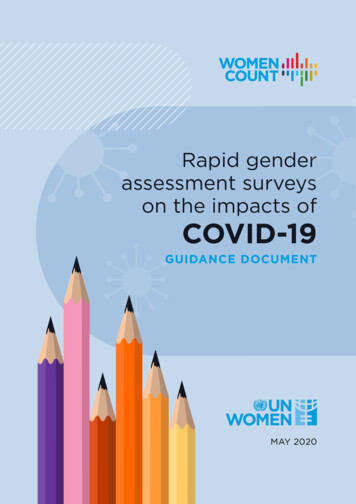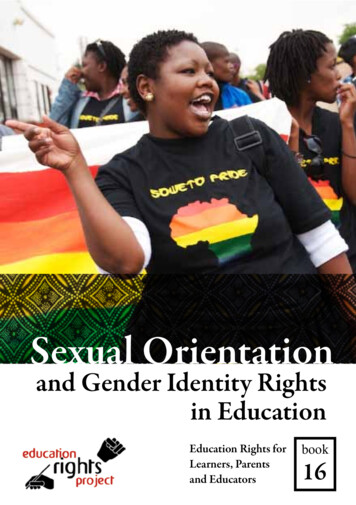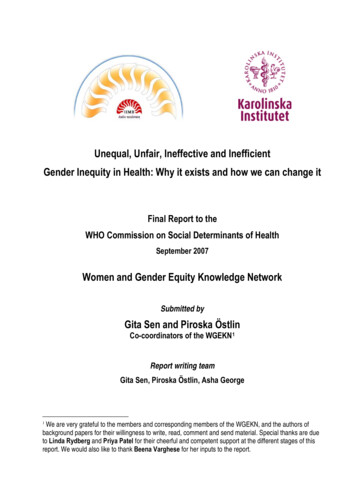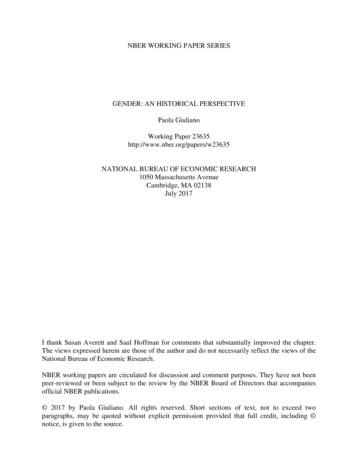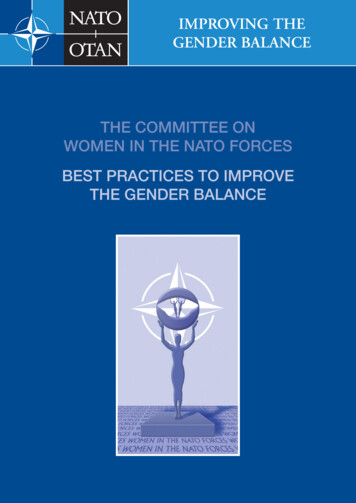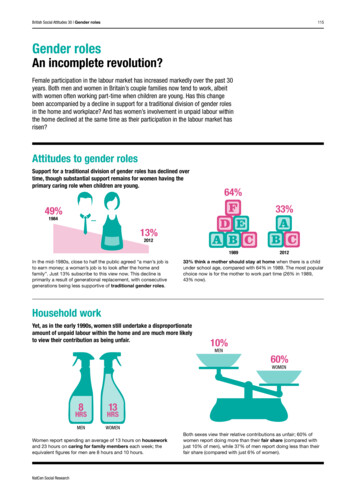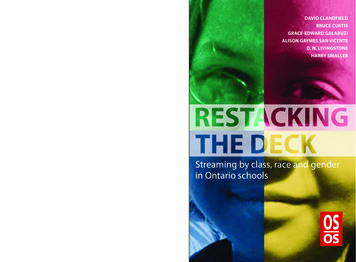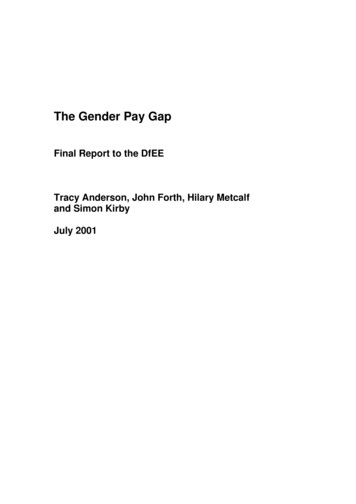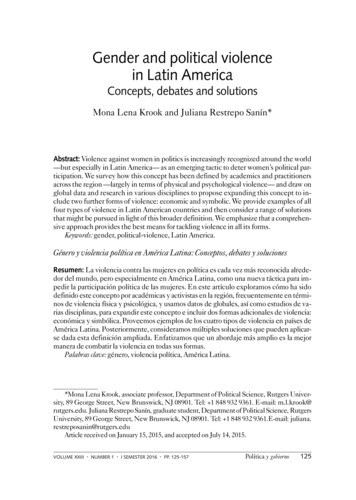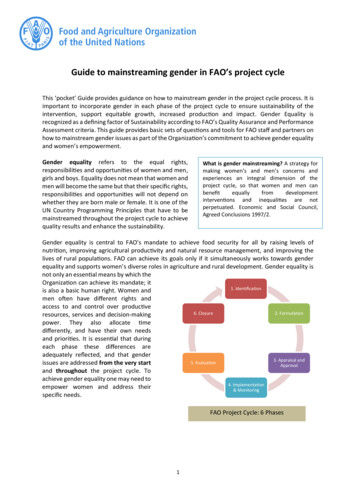
Transcription
Guide to mainstreaming gender in FAO’s project cycleThis ‘pocket’ Guide provides guidance on how to mainstream gender in the project cycle process. It isimportant to incorporate gender in each phase of the project cycle to ensure sustainability of theintervention, support equitable growth, increased production and impact. Gender Equality isrecognized as a defining factor of Sustainability according to FAO’s Quality Assurance and PerformanceAssessment criteria. This guide provides basic sets of questions and tools for FAO staff and partners onhow to mainstream gender issues as part of the Organization’s commitment to achieve gender equalityand women’s empowerment.Gender equality refers to the equal rights,responsibilities and opportunities of women and men,girls and boys. Equality does not mean that women andmen will become the same but that their specific rights,responsibilities and opportunities will not depend onwhether they are born male or female. It is one of theUN Country Programming Principles that have to bemainstreamed throughout the project cycle to achievequality results and enhance the sustainability.What is gender mainstreaming? A strategy formaking women’s and men’s concerns andexperiences an integral dimension of theproject cycle, so that women and men canbenefitequallyfromdevelopmentinterventions and inequalities are notperpetuated. Economic and Social Council,Agreed Conclusions 1997/2.Gender equality is central to FAO’s mandate to achieve food security for all by raising levels ofnutrition, improving agricultural productivity and natural resource management, and improving thelives of rural populations. FAO can achieve its goals only if it simultaneously works towards genderequality and supports women’s diverse roles in agriculture and rural development. Gender equality isnot only an essential means by which theOrganization can achieve its mandate; it1. Identificationis also a basic human right. Women andmen often have different rights andaccess to and control over productive6. Closure2. Formulationresources, services and decision-makingpower. They also allocate timedifferently, and have their own needsand priorities. It is essential that duringeach phase these differences areadequately reflected, and that gender3. Appraisal and5. Evaluationissues are addressed from the very startApprovaland throughout the project cycle. Toachieve gender equality one may need to4. Implementationempower women and address their& Monitoringspecific needs.FAO Project Cycle: 6 Phases1
The goal of FAO’s Policy on Gender Equality is to achieve equality between women and men insustainable agricultural production and rural development for the elimination of hunger and poverty.FAO Gender Equality ObjectivesThe following five objectives guide FAO’s work in advancing equality of voice, agency and access to resources andservices between women and men.1. Decision-making: Women participate equally with men as decision-makers in rural institutions and in shapinglaws, policies and programmes.2. Resources: Women and men have equal access to and control over decent employment and income, land andother productive resources.3. Goods, Services and Markets: Women and men have equal access to goods and services for agriculturaldevelopment, and to markets.4. Work burden: Women’s work burden is reduced by 20 percent through improved technologies, services andinfrastructure.5. Support: The share of total agricultural aid committed to projects related to women and gender equality isincreased to 30 percent.FAO’s Policy on Gender Equality requires that gender analysis is incorporated in the identification and formulationof all field programmes and projects, and gender-related issues are taken into account in project approval andimplementation processes such as collecting base-line data and in the monitoring and evaluation.Gender analysis is the study of the different roles of women and men to better understand what theydo, what resources they have, what their needs and priorities are in a specific context, and howdecisions are made within the household and the communities. It aims at providing robust evidenceon women and men’s specific priorities, needs and responsibilities, to reduce the risk of designing aproject based on incorrect assumptions and stereotypes. It also provides insights in how men andwomen are affected by the problem being addressed so that solutions are informed by this knowledgeand they can participate in decision-making.The gender equality checklist (described in Annex 1) is a tool to be used in each project cycle phaseto track progress and serve as a reminder of FAO’s five gender equality objectives. Annex 2 presentsguidance on how to conduct a more detailed gender analysis.This guide indicates for each project cycle phase which steps and tools can help you integrate a genderperspective. What tools to use and to what level of detail depends for a large part on time andresources availability. We invite you to consult the Regional gender officers or the Gender focal points(GFPs) in the country, sub-region or relevant technical division for guidance and advice. In generalresponsibilities of the different staff in terms of mainstreaming gender are as follows:FAO staffSocial Policies and RuralInstitution Division (ESP)Regional Gender OfficersPPRCGender Focal Points (GFPs)Country Offices/Technical DivisionsADGs/Division DirectorsAll professional staffRoles/ResponsibilitiesCoordinate gender mainstreaming work within the Organization, carry outcapacity development, build and share knowledge and data, supportadequate implementation and monitoring mechanisms, and provide policyadvice and technical expertise to Member states on gender issues.Coordinate gender mainstreaming work in the region, carry out capacitydevelopment, build and share knowledge and data, and provide policyadvice and technical expertise to Member countries on gender issues inthe region.Appraise project documents on compliance with FAO’s Gender EqualityPolicy.Raise awareness, provide technical support on gender mainstreaming (20%of their time) at country level, or in a specific technical field.Ensure budget allocation to women specific targeted interventions andgender equality, enable GFPs to dedicate 20% of their time, and Monitoringand evaluation.Ensure quality of programme and project designs and normative work,with adequate gender mainstreaming.2
Table: Steps to integrate gender in the project cycle, discussed in more detail below.Project Cycle Phases1.IdentificationDefine the problem and identifysolutionsResult: Project Proposal/Concept Note2.FormulationDefine Impact and outcomes, outputsand activities, including a logframe andbudgetResult: Project Document, includinglogframe and budget3.Appraisal and approvalAssess the project based on qualitycriteria (by PPRC)Result: Approval4.ImplementationImplement the project according toproposed work plan and budgetResult: Base-line and Progress reportsMid-Term reviewIntegration of Gender PerspectiveStakeholder analysis: Consult male and female stakeholdersand local institutions. Establish how a problem or issue affectsdifferent stakeholders and the view of men and women whatwill contribute to solving their problems.ESRM: Risk Assessment: (ESS) 8: Gender EqualityAssign Gender MarkerGender analysis: Generate insights on how the project can:Contribute to men and women’s equitable access toresources, food and nutrition and increase gender equality.Benefit both women and men by addressing their differentneeds and capacities.Setting priorities: Address the gender implications in theformulation of the expected Impact, outcomes and outputs,complemented by gender-sensitive indicators. If a problemseverely affects women, ensure a specific outcome, output andactivities are included to address their specific constraints.Institutional assessment: Identify gender capacity gaps.Budget: Allocate sufficient human and financial resources toensure women’s participation and benefits.Appraise the project on Gender Equality Criteria: The project:1) takes into consideration the priorities, opportunities, needs,constrains and knowledge of both women and men, asidentified by the gender and stakeholder analysis 2. includesactivities and outputs that address gender inequalities and aimsto ensure equal benefits for women and men.Build on/continue/instigate a baseline survey with a social andgender focusCapacity development: Develop the gender capacity and raisegender awareness among the project staff and relevant partnersinvolved in the implementation.M&E: The collection and analysis of sex-disaggregated data forMonitoring and evaluation to track implementation progress,and participatory monitoring involving both women and men.Adapt: implement changes or add new activities, if correctivemeasures are needed.5.EvaluationDocument progress at the end of theproject, results achieved and impactResult: Evaluation ReportAnalyse and document: progress achieved at the end of theimplementation phase, the project’s strengths and weaknessesand the differential effects and potential long- term impacts ofthe project on women and men.6.Capture lessons learnt: regarding the benefits of mainstreaminggender for the sustainability of the project outcomes andimpact: balance score card.Disseminate gender-related lessons learned since these are ofgreat value for new projects.Project ClosureResult: Completion Report3
FAO deals explicitly with Gender Equality policy in the Project Cycle in the following ways:1.Identification: Concept Note2.Formulation: Project document3.6.AppraisalProject ClosureGender is explicitly addressed in three ways in the ConceptNote: 1. ESRM, 2. Gender Marker and; 3. as a definingfactor of sustainabilitySame as Concept Note, more detail is required under riskmanagement and (in all cases) under SustainabilityAppraisal by PPRC on Gender equality CriteriaTerminal Report (scorecard) – Gender equality questionsCountry Programme Framework and Country Gender AssessmentEach project will be designed and implemented in the context of a Country Programme Framework. Inaddition, mainstreaming gender in a project builds upon information in the Country GenderAssessment (CGA). A part of FAO’s Gender Equality minimum standards, the country genderassessment is a specific analysis of the gender dimensions of the agriculture and rural developmentsectors. Specifically, it explores existing gender relations and inequalities in various subsectors ofagriculture, their causes and impact on the economic and social development of rural areas, and onfood security and nutrition. The aim of the assessment is to explore the situation of rural womencompared to men’s and to understand the extent to which they are able to realize their rights andpotential in areas where FAO is mandated to assist its Member Countries, in line with the Policy onGender Equality and strategic framework and objectives. The CGA also informs country level planningand programming, including the Country Programme Framework (CPF).Below, for each phase the recommended tools are described, “Real life” examples are included andpractical “How to” guidance is provided. The symbols below are used throughout this guide:Real-life examplePractical tips and advice onHow to implement a specifictool.Project Cycle phase 1. IdentificationBy applying a gender perspective early in the project design, FAO will be able to plan and implementinterventions that best identify and address the needs of both women and men of different ages andsocio-economic groups.1.1 Gender –Sensitive Stakeholder Analysis.In this phase of the project cycle gender-sensitive stakeholder analysis is crucial. This is a methodaccounting for and incorporating the needs of those who have a ‘stake’ through a broad consultationwith adequate representation of men and women. A gender-sensitive approach will enable projectformulators to look at stakeholders as “women” and “men” with specific needs and priorities, andensure that their specific perspectives are considered and addressed by the project.4
Gender-sensitive stakeholder analysis helps you to: identify the male and female individual stakeholders or institutions/groups that shouldbe involved in the project formulation and implementation; decide how to best address their interests and needs, and determine their priorities; address constraints of men and women to participate or access the project benefits; find out how the different male and female stakeholders are likely to affect or beaffected by the project, to make most appropriate decisions on how to involve eachstakeholder.Stakeholder analysis is done in a participatory manner1 to ensure that the decision-making is open andwithout preconceived ideas.Botswana - Four distinct groups of stakeholders:In the Agricultural Services Support Programme (ASSP) in the Republic of Botswana, selectedsmallholders would participate in the small-scale irrigation scheme to be established. Withinthis group, there are four principal groups/stakeholders: (i) smallholder households hiringtractors for land preparation and planting; (ii) owners of draught animals who continue tocultivate part of their land using draught animals and may hire out their draught power toothers; (iii) female heads of households as smallholder farmers in their own right (owning 41percent of the holdings), and women in married households; and (iv) boys and girls currently,or potentially, engaged in smallholder agricultural production. The specific needs andchallenges of women and youth need to be considered to ensure equity in the opportunities toparticipate in training, the allocation of irrigable land, and membership and leadership of localdecision-making bodies. Secondary stakeholders include agro-service providers and agrodealers.While conducting the stakeholder analysis, it is important to consider that: Women and girls, in many contexts, are not adequately represented and tend to havefewer o
In this phase of the project cycle gender-sensitive stakeholder analysis is crucial. This is a method accounting for and incorporating the needs of those who have a stake through a broad consultation with adequate representation of men and women. A gender-sensitive approach will enable project formulators to look at stakeholders as women _ and men _ with specific needs and priorities, and .
